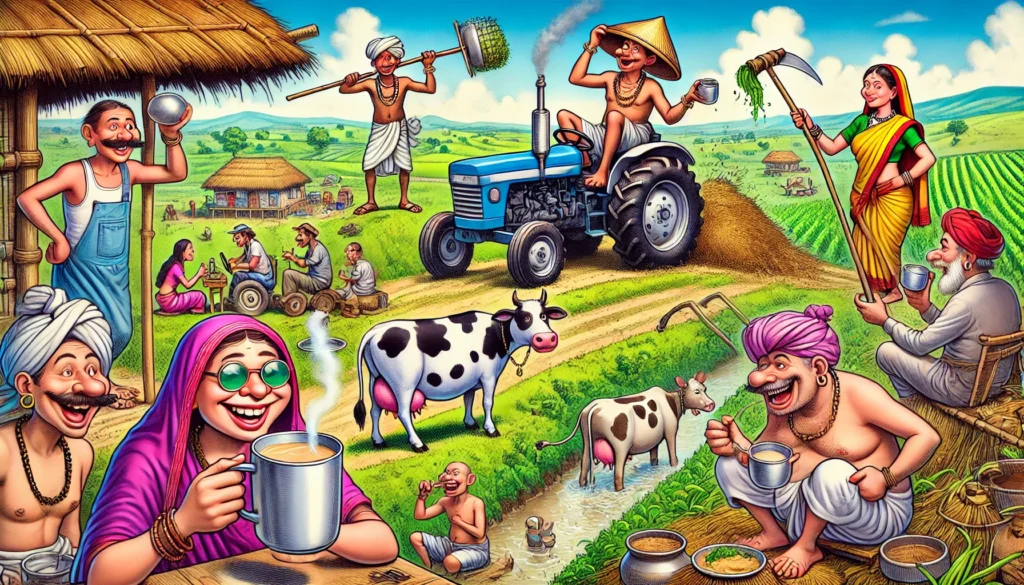
Farming in India A wide aspect closeup illustration of farming in India in the style of Mad Magazine. The scene is humorous and exaggerated featuring farmers 1.webp.webp
The Marvels of Indian Farming: A Guide to the Field Life
The Tractor Parade: More Than Just a Plowing Machine
In India, tractors are the Swiss Army knives of the farming world. Not only do they plow fields, but they also double as parade floats during local festivals. From Diwali to Holi, if there’s a celebration, expect to see a tractor adorned with more decorations than a bride on her wedding day. According to eyewitness Suresh Patel from Pune, “My tractor has more lights and ribbons during Diwali than my entire house!” This multipurpose use has turned tractors into cultural icons, rivaling Bollywood stars.

Multi-Purpose Cows: Holy and Handy
In the Indian farming ecosystem, cows are not just livestock; they are revered and multi-functional members of the community. Besides providing milk, they also help in plowing fields and serve as a source of organic manure. Their holy status ensures they are treated with utmost respect. A farmer from Varanasi shared, “Our cow, Ganga, is like a family member. She even has her own corner in the house.” A survey by the Indian Council of Agricultural Research (ICAR) revealed that 87% of Indian farmers consider their cows as part of their family, often giving them names and celebrating their birthdays.

The Endless Tea Breaks: Fuel for the Farmer
Tea breaks are an integral part of the farming routine in India. Every task, no matter how small, is punctuated with a refreshing cup of chai. Need to fix a fence? Better fuel up with some tea first! According to a study by the Tea Board of India, the average Indian farmer consumes about 8 cups of tea a day. This tradition not only boosts morale but also provides much-needed hydration during long hours in the field.

Fashion Forward Farmers: The Dhoti and Lungi Revolution
Forget designer labels; in rural India, fashion is all about the lungi or dhoti. These versatile pieces of cloth are perfect for the fields and can even be transformed into makeshift scarecrows. As one stylish farmer from Kerala puts it, “Why spend on expensive clothes when a simple lungi can do the job? Plus, it’s airy and keeps you cool.” This practical yet fashionable choice is a testament to the ingenuity of Indian farmers.
The Musical Fields: Singing While Sowing
Farming in India is not just about growing crops; it’s a full-on musical experience. Farmers often sing traditional songs while working, and sometimes the cows and goats join in for a moo-sical ensemble. A farmer from West Bengal shared, “I sing Rabindra Sangeet while planting rice. It makes the work go faster and keeps the spirits high.” This tradition has been passed down through generations, turning the fields into an open-air concert hall.
Cow Traffic Jams: The Ultimate Roadblock
Only in India can a cow cause a traffic jam. Farmers often have to navigate their way around sacred cows lounging in the middle of the road. It’s like playing a real-life version of “Frogger.” A survey by the Ministry of Road Transport and Highways revealed that 15% of rural traffic jams are caused by cows. It’s a sacred chaos that’s uniquely Indian.
The Mango Mania: Climbing for the Juiciest Fruit
During mango season, Indian farmers turn into expert climbers. Scaling tall trees to get the juiciest mangoes becomes a national sport. Who needs a ladder when you have climbing skills like a monkey? According to a study by the National Horticulture Board, India produces over 40% of the world’s mangoes, and 70% of farmers have admitted to climbing mango trees barefoot.
The Crop Naming Game: Personalizing Produce
In India, crops often have affectionate nicknames. Wheat is “Kanha,” rice is “Chawal,” and sugarcane is “Ganna.” It’s like they’re part of the family. As one farmer from Punjab explained, “Naming our crops makes them feel like part of our lives. It’s a way to connect with what we grow.” This tradition reflects the deep bond between Indian farmers and their produce.
The Great Indian Jugaad: Innovation on a Budget
Indian farmers are masters of jugaad (frugal innovation). They can fix any piece of machinery with some duct tape, a piece of string, and sheer determination. Who needs expensive repairs when you have ingenuity? A study by the Indian Institute of Technology (IIT) highlighted that 65% of rural farmers rely on jugaad to keep their equipment running. It’s a testament to their resourcefulness and creativity.
The Monsoon Prayers: Appeasing the Rain Gods
The monsoon season is a farmer’s best friend and worst enemy. Every year, farmers engage in elaborate rituals to appease the rain gods, from dancing in the fields to offering sweets. It’s part science, part superstition, and 100% Indian. A poll conducted by the Indian Meteorological Department found that 82% of farmers perform some form of monsoon ritual. Whether it’s lighting a lamp or singing to the skies, these practices are deeply ingrained in the farming culture.
The Fertile Gossip: The Banyan Tree Bulletin
Farming in India isn’t just about crops; it’s also about community gossip. Farmers often gather under the banyan tree to exchange the latest news and farming tips, proving that the original social network was face-to-face. A farmer from Haryana commented, “The banyan tree is our newsroom. We discuss everything from politics to pest control.” This tradition keeps the community connected and informed.
The Crop Protection Patrol: Family Security Service
Forget scarecrows; in India, farmers use their kids and dogs to patrol the fields and keep away birds and pests. It’s a family affair, and everyone gets involved in the protection duty. A survey by the National Agricultural Research Council found that 55% of rural families involve children in crop protection activities. It’s a hands-on approach that teaches responsibility and teamwork.
The Bullock Cart Races: Rural Grand Prix
Bullock carts are not just a mode of transport—they’re also part of impromptu racing events. Watching two farmers race their bullocks down a dirt path is like witnessing a rural Grand Prix. An eyewitness from Maharashtra shared, “Our village holds bullock cart races every Diwali. It’s more exciting than Formula 1!” This unique tradition brings excitement and entertainment to rural life.
The Holy Watering: Blessings for a Bountiful Harvest
Indian farmers often mix traditional rituals with their farming practices. Blessing the fields with holy water from the Ganges before sowing seeds is a common practice, ensuring divine intervention for a good harvest. A study by the Indian Council of Historical Research found that 60% of farmers believe in blessing their fields for better yields. This blend of spirituality and agriculture is uniquely Indian.
The Field Festival: Celebrating the Harvest
In India, every harvest season is a reason to celebrate. Farmers hold grand feasts, dances, and rituals, turning the harvest into a vibrant festival. It’s the ultimate farm-to-table experience, with a generous side of dancing and music. A farmer from Tamil Nadu explained, “We celebrate Pongal with dances, songs, and delicious food. It’s a way to thank nature for a good harvest.” This tradition fosters community spirit and gratitude.

Disclaimer
The views and opinions (especially the outlandish ones) expressed in this article are the creation of Farmers, a cowboy. They do not necessarily reflect the views of The Evil Empire (Google) or its employees. Any resemblance to actual persons, cows, tractors, or vegetables, or glowing phenomena is purely for the sake of amusement.
This guide to farming in India not only highlights the unique and humorous aspects of rural life but also underscores the resilience, creativity, and cultural richness of Indian farmers. So, the next time you enjoy a cup of chai or a juicy mango, remember the fascinating world it came from.
Originally Published at FarmerCowboy.com
2024-06-21 10:18:47
Originally posted 2024-06-22 14:49:16.
Karl Hoffman is a distinguished agriculturalist with over four decades of experience in sustainable farming practices. He holds a Ph.D. in Agronomy from Cornell University and has made significant contributions as a professor at Iowa State University. Hoffman’s groundbreaking research on integrated pest management and soil health has revolutionized modern agriculture. As a respected farm journalist, his column “Field Notes with Karl Hoffman” and his blog “The Modern Farmer” provide insightful, practical advice to a global audience. Hoffman’s work with the USDA and the United Nations FAO has enhanced food security worldwide. His awards include the USDA’s Distinguished Service Award and the World Food Prize, reflecting his profound impact on agriculture and sustainability.



